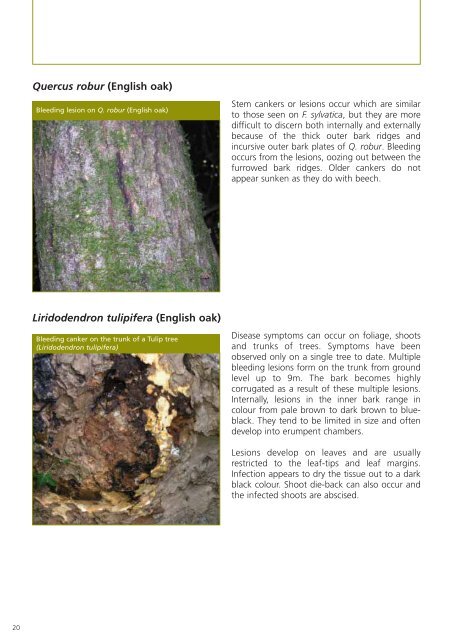Phytophthora ramorum - The Food and Environment Research ...
Phytophthora ramorum - The Food and Environment Research ...
Phytophthora ramorum - The Food and Environment Research ...
Create successful ePaper yourself
Turn your PDF publications into a flip-book with our unique Google optimized e-Paper software.
Quercus robur (English oak)<br />
Bleeding lesion on Q. robur (English oak)<br />
Stem cankers or lesions occur which are similar<br />
to those seen on F. sylvatica, but they are more<br />
difficult to discern both internally <strong>and</strong> externally<br />
because of the thick outer bark ridges <strong>and</strong><br />
incursive outer bark plates of Q. robur. Bleeding<br />
occurs from the lesions, oozing out between the<br />
furrowed bark ridges. Older cankers do not<br />
appear sunken as they do with beech.<br />
Liridodendron tulipifera (English oak)<br />
Bleeding canker on the trunk of a Tulip tree<br />
(Liridodendron tulipifera)<br />
Disease symptoms can occur on foliage, shoots<br />
<strong>and</strong> trunks of trees. Symptoms have been<br />
observed only on a single tree to date. Multiple<br />
bleeding lesions form on the trunk from ground<br />
level up to 9m. <strong>The</strong> bark becomes highly<br />
corrugated as a result of these multiple lesions.<br />
Internally, lesions in the inner bark range in<br />
colour from pale brown to dark brown to blueblack.<br />
<strong>The</strong>y tend to be limited in size <strong>and</strong> often<br />
develop into erumpent chambers.<br />
Lesions develop on leaves <strong>and</strong> are usually<br />
restricted to the leaf-tips <strong>and</strong> leaf margins.<br />
Infection appears to dry the tissue out to a dark<br />
black colour. Shoot die-back can also occur <strong>and</strong><br />
the infected shoots are abscised.<br />
20
















